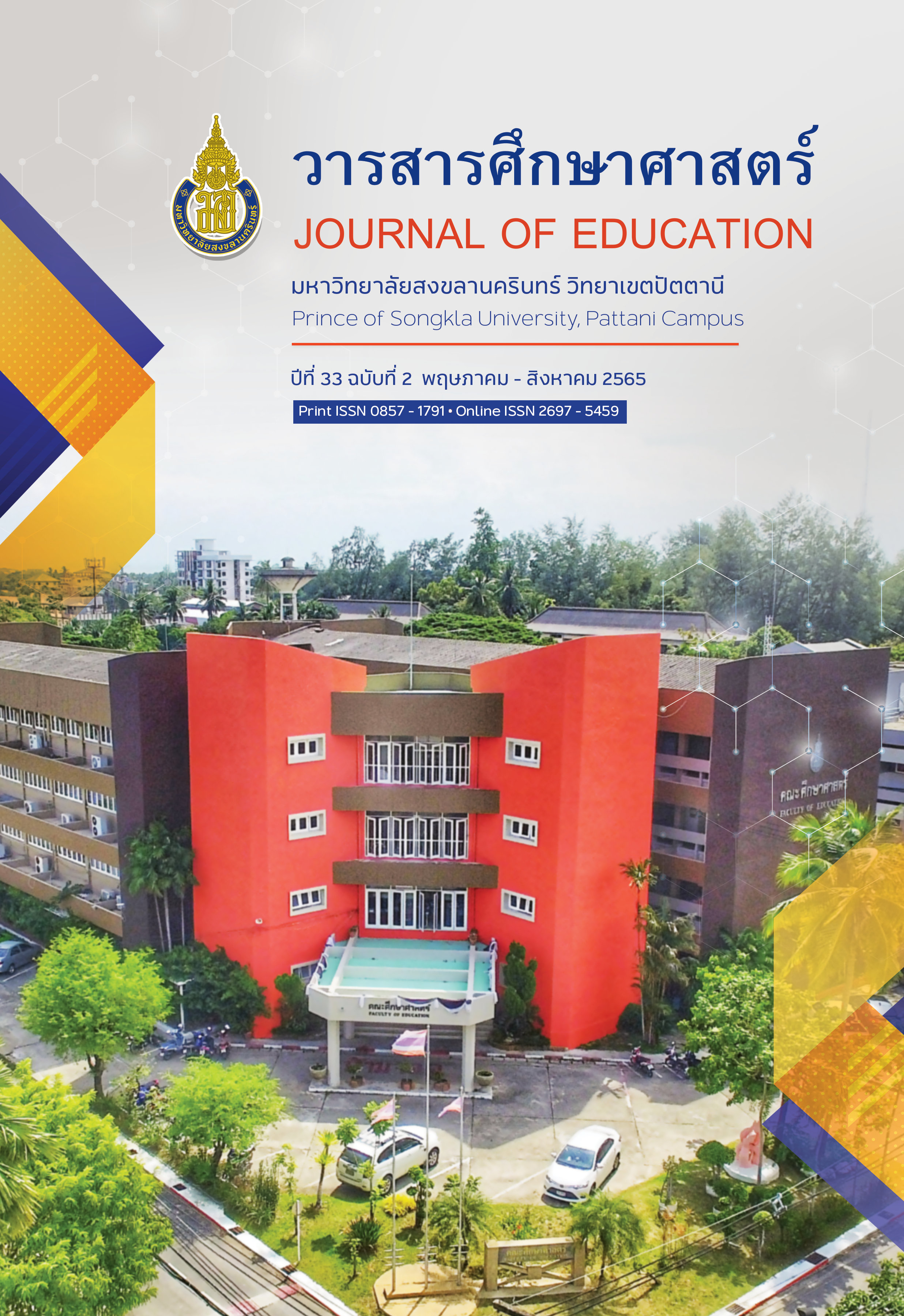Development and Validation of Climate Awareness Measurement Model of High School Students
Main Article Content
Abstract
Youth plays a significant key role to the world climate mitigation success; thus, students need to be insightful in the climate system knowledge, as well as climate factors interaction between oneself, community, and world climate. Educating and assessing students need to be followed an effective framework; climate awareness is one of the most significant climate literacy components which is needed for climate action-driven. The study aims to develop and validate the climate awareness measurement for high school students. The participants are one-thousand thirty-eight Thai high school students, randomly sampling. The data were collected using a scale measurement through an online survey platform. The result shows that the climate awareness measurement instrument comprises of thirty-two questions in form of the Likert-scale test. The test verification indicates that the reliability (Cronbach’s alpha coefficient) was .801 - .877, while the content validity (IOC) was 1.00, and the construct validity was verified with second-order confirmatory factor analysis, adopting Mplus. The climate awareness measurement model is adequate fit. (χ2=246.066, df=212, p-value=0.0542, CFI=0.998, RMSEA=0.012, SRMR=0.030)
Article Details

This work is licensed under a Creative Commons Attribution-NonCommercial 4.0 International License.
References
Azevedo, J., & Marques, M. (2017). Climate literacy: a systematic review and model integration. International Journal of Global Warming, 12(3-4), 414-430. Retrieved from https://doi.org/10.1504/IJGW.2017.084789
Basu, S. J., Barton, A. C., Clairmont, N., & Locke, D. (2009). Developing a framework for critical science agency through case study in a conceptual physics context. Cultural studies of science education, 4(2), 345-371. Retrieved from https://doi.org/10.1007/s11422-008-9135-8
Bedford, D. (2016). Does climate literacy matter? A case study of US students’ level of concern about anthropogenic global warming. Journal of Geography, 115(5), 187-197. Retrieved from https://doi.org/10.1080/00221341.2015.1105851
Browne, M. W., & Cudeck, R. (1989). Single sample cross-validation indices for covariance structures. Multivariate behavioral research, 24(4), 445-455. Retrieved from http://dx.doi.org/10.1207/s15327906mbr2404_4
Chen, B., & Lee, J. (2020). Household waste separation intention and the importance of public policy. International Trade, Politics and Development, Retrieved from http://dx.doi.org/10.1108/ITPD-03-2020-0008
Clifford, K. R., & Travis, W. R. (2018). Knowing climate as a social-ecological-atmospheric construct. Global Environmental Change, 49, 1-9. Retrieved from https://doi.org/10.1016/j.gloenvcha.2017.12.007
Climate Change Initiative. (2010). Climate change education for sustainable development. Paris.
Dupigny-Giroux, L. A. L. (2008). Introduction-climate science literacy: a state of the knowledge overview. Physical Geography, 29(6), 483-486, Retrieved from https://doi.org/10.2747/0272-3646.29.6.483
GCRP, U. (2009). Climate literacy: the essential principles of climate science. (2nd ed.). US Global Change Research Program.
Gube, M. (2016). The (un) sustainability of hotel breakfast buffets: Food and its potential to mitigate greenhouse gas emissions in the context of tourism.
Harrington, J. (2008). Misconceptions: Barriers to improved climate literacy. Physical Geography, 29(6), 575-584. Retrieved from https://doi.org/10.2747/0272-3646.29.6.575
Hu, L. T., & Bentler, P. M. (1999). Cutoff criteria for fit indexes in covariance structure analysis: Conventional criteria versus new alternatives. Structural equation modeling: a multidisciplinary journal, 6(1), 1-55. Retrieved from https://doi.org/10.1080/10705519909540118
Janmaimool, P. (2017). Application of protection motivation theory to investigate sustainable waste management behaviors. Sustainability, 9(7), 1079. Retrieved from https://doi.org/10.3390/su9071079
Juvan, E., Grün, B., & Dolnicar, S. (2018). Biting off more than they can chew: food waste at hotel breakfast buffets. Journal of Travel Research, 57(2), 232-242. Retrieved from https://doi.org/10.1177/0047287516688321
Kanjanawasee, S. (2017). Classical test theory. Bangkok: Chulalongkorn University Press. [in Thai]
Leiserowitz, A., Smith, N., & Marlon, J. R. (2011). American teens’ knowledge of climate change. Yale University. New Haven, CT: Yale Project on Climate Change Communication, 5.
McCaffrey, M. S., & Buhr, S. M. (2008). Clarifying climate confusion: Addressing systemic holes, cognitive gaps, and misconceptions through climate literacy. Physical Geography, 29(6), 512-528. Retrieved from https://doi.org/10.2747/0272-3646.29.6.512
McNeill, K. L., & Vaughn, M. H. (2012). Urban high school students’ critical science agency: Conceptual understandings and environmental actions around climate change. Research in science education, 42(2), 373-399. Retrieved from https://doi.org/10.1007/s11165-010-9202-5
Miléř, T., & Sládek, P. (2011). The climate literacy challenge. Procedia-Social and Behavioral Sciences, 12, 150-156. Retrieved from https://doi.org/10.1016/j.sbspro.2011.02.021
Muthén, L. K., & Muthén, B.O. (2017). Mplus user's guide: Eight Edition. Los Angeles, CA: Muthén & Muthén.
Nations, U. (2015). United Nations Framework Convention on Climate Change. Retrieved from
United Nations https://unfccc.int/resource/docs/convkp/conveng.pdf
Niepold, F., Herring, D., & McConville, D. (2007). The case for climate literacy in the 21st Century. Paper presented at the 5th International Symposium on Digital Earth.
OECD. (2016). PISA 2015 assessment and analytical framework: Science, reading, mathematic and financial literacy: OECD publishing.
Pedersen, J. T. S., & Manhice, H. (2020). The hidden dynamics of household waste separation: An anthropological analysis of user commitment, barriers, and the gaps between a waste system and its users. Journal of Cleaner Production, 242, 116285, Retrieved from https://doi.org/10.1016/j.jclepro.2019.03.281
Selin, J. (2018). Towards reducing food waste in a hotel breakfast buffet: A case study of Profil Hotels Calmar Stadshotell.
Shwom, R., Isenhour, C., Jordan, R. C., McCright, A. M., & Robinson, J. M. (2017). Integrating the social sciences to enhance climate literacy. Frontiers in Ecology and the Environment, 15(7), 377-384, Retrieved from https://doi.org/10.1002/fee.1519
Thailand Office of Natural Resources and Environmental Policy and Planning. (2015). Master plan for climate change on 2015-2050. Retrieved from shorturl.at/aTUYZ [in Thai]
The Thailand Research Fund. (2016). Thailand's second assessment report on climate change 2016. Bangkok: The Thailand Research Fund. [in Thai]
Van der Linden, S., Leiserowitz, A., Rosenthal, S., & Maibach, E. (2017). Inoculating the public against misinformation about climate change. Global Challenges, 1(2), 1600008, Retrieved from https://doi.org/10.1002/gch2.201600008
Vassanadumrongdee, S., & Kittipongvises, S. (2018). Factors influencing source separation intention and willingness to pay for improving waste management in Bangkok, Thailand. Sustainable. Environment Research, 28(2), 90-99, Retrieved from https://doi.org/10.1016/j.serj.2017.11.003
Wynne, B. (2016). Misunderstood misunderstanding: Social identities and public uptake of science. Public understanding of science, 1, 281-304.
Zehr, S. C. (2016). Public representations of scientific uncertainty about global climate change. Public understanding of science, 9(2000), 85-103.


